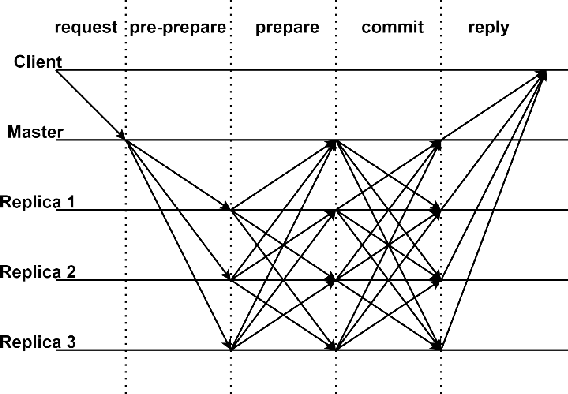Shizhong Xu
ESCM: An Efficient and Secure Communication Mechanism for UAV Networks
Apr 26, 2023



Abstract:UAV (unmanned aerial vehicle) is gradually entering various human activities. It has also become an important part of satellite-air-ground-sea integrated network (SAGS) for 6G communication. In order to achieve high mobility, UAV has strict requirements on communication latency, and it cannot be illegally controlled as weapons of attack with malicious intentions. Therefore, an efficient and secure communication method specifically designed for UAV network is required. This paper proposes a communication mechanism named ESCM for the above requirements. For high efficiency of communication, ESCM designs a routing protocol based on artificial bee colony algorithm (ABC) for UAV network to accelerate communication between UAVs. Meanwhile, we plan to use blockchain to guarantee the communication security of UAV networks. However, blockchain has unstable links in high mobility network scenarios, resulting in low consensus efficiency and high communication overhead. Therefore, ESCM also introduces the concept of the digital twin, mapping the UAVs from the physical world into Cyberspace, transforming the UAV network into a static network. And this virtual UAV network is called CyberUAV. Then, in CyberUAV, we design a blockchain system and propose a consensus algorithm based on network coding, named proof of network coding (PoNC). PoNC not only ensures the security of ESCM, but also further improves the performance of ESCM through network coding. Simulation results show that ESCM has obvious advantages in communication efficiency and security. Moreover, encoding messages through PoNC consensus can increase the network throughput, and make mobile blockchain static through digital twin can improve the consensus success rate.
Performance Analysis and Comparison of Non-ideal Wireless PBFT and RAFT Consensus Networks in 6G Communications
Apr 18, 2023Abstract:Due to advantages in security and privacy, blockchain is considered a key enabling technology to support 6G communications. Practical Byzantine Fault Tolerance (PBFT) and RAFT are seen as the most applicable consensus mechanisms (CMs) in blockchain-enabled wireless networks. However, previous studies on PBFT and RAFT rarely consider the channel performance of the physical layer, such as path loss and channel fading, resulting in research results that are far from real networks. Additionally, 6G communications will widely deploy high-frequency signals such as terahertz (THz) and millimeter wave (mmWave), while performances of PBFT and RAFT are still unknown when these signals are transmitted in wireless PBFT or RAFT networks. Therefore, it is urgent to study the performance of non-ideal wireless PBFT and RAFT networks with THz and mmWave signals, to better make PBFT and RAFT play a role in the 6G era. In this paper, we study and compare the performance of THz and mmWave signals in non-ideal wireless PBFT and RAFT networks, considering Rayleigh Fading (RF) and close-in Free Space (FS) reference distance path loss. Performance is evaluated by five metrics: consensus success rate, latency, throughput, reliability gain, and energy consumption. Meanwhile, we find and derive that there is a maximum distance between two nodes that can make CMs inevitably successful, and it is named the active distance of CMs. The research results not only analyze the performance of non-ideal wireless PBFT and RAFT networks, but also provide important references for the future transmission of THz and mmWave signals in PBFT and RAFT networks.
Performance Analysis of Non-ideal Wireless PBFT Networks with mmWave and Terahertz Signals
Mar 28, 2023



Abstract:Due to advantages in security and privacy, blockchain is considered a key enabling technology to support 6G communications. Practical Byzantine Fault Tolerance (PBFT) is seen as the most applicable consensus mechanism in blockchain-enabled wireless networks. However, previous studies on PBFT do not consider the channel performance of the physical layer, such as path loss and channel fading, resulting in research results that are far from real networks. Additionally, 6G communications will widely deploy high frequency signals such as millimeter wave (mmWave) and terahertz (THz), while the performance of PBFT is still unknown when these signals are transmitted in wireless PBFT networks. Therefore, it is urgent to study the performance of non-ideal wireless PBFT networks with mmWave and THz siganls, so as to better make PBFT play a role in 6G era. In this paper, we study and compare the performance of mmWave and THz signals in non-ideal wireless PBFT networks, considering Rayleigh Fading (RF) and close-in Free Space (FS) reference distance path loss. Performance is evaluated by consensus success rate and delay. Meanwhile, we find and derive that there is a maximum distance between two nodes that can make PBFT consensus inevitably successful, and it is named active distance of PBFT in this paper. The research results not only analyze the performance of non-ideal wireless PBFT networks, but also provide an important reference for the future transmission of mmWave and THz signals in PBFT networks.
 Add to Chrome
Add to Chrome Add to Firefox
Add to Firefox Add to Edge
Add to Edge